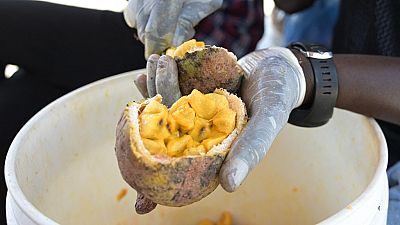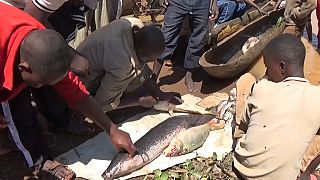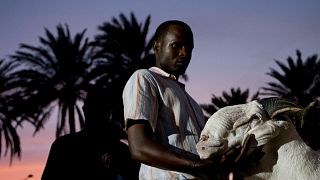Senegal
In the hustle and bustle of a market on the outskirts of Dakar, men unload three 60-tonne trucks that block the roadway long enough to deliver their cargo of maad, a delicate and sought-after fruit.
Sandika, in Pikine, is the largest fruit market in Senegal. It's the place to be for maad, the star of the moment. From here, the fruit is redistributed throughout the capital and the interior of the country, where men and women, young and old, revel in its juicy, tangy, sweet yellow pulp.
The season lasts four months, from May to August. The fruit is fragile and must be picked quickly. Among the workers who toil in the heat around the trucks, some sort the fruit according to its condition, others fill baskets with it, while the last dump it in piles on the ground.
"The unloading will be finished by the end of the day", assures Dame Sarr, one of the owners of the merchandise. The young merchant and his uncle have invested six million CFA francs (9,130 euros) in the load. They hope to make a profit of 700,000 CFA francs (1,062 euros).
All around, maad is to be found on almost every stall. The fruit of the Saba Senegalensis, whose globular shell contains seeds coated with edible flesh, grows on wild lianas in West Africa. The maad is known by other names in Côte d'Ivoire, Mali, and Guinea.
- Popular fruit - It's especially popular in Senegal. It is sold on almost every street corner in Dakar. It is eaten with salt, sugar or chilli. Some have created their own brand, which they promote on social networks. It's a local source of income for those who harvest, transport, sell or process it.
Maad is rich in fiber and vitamins," says nutritionist Ndeye Khady Dia. She advises against swallowing the hard-to-digest kernels and warns against the risk of choking in children.
A few customers crowd around Dame Sarr's stall, bucket or basin in hand. "The customers are here today, and that's good for me. If I don't sell all the merchandise, I'll have to slash the price tomorrow, as the maad loses a little of its quality with each passing day", he explains, seated under a makeshift umbrella tent.
Dame, aged 28, has separated his merchandise into the finest specimens, which he sells for at least 4,200 CFA francs (six euros) a bucket of 40 fruits, and the others, which he sells for 2,200 CFA francs (3 euros). As for the 20 kg box, it can cost from 20,000 to 25,000 CFA francs (30 to 38 euros).
- Risky investment - "Maad is a high-risk investment. It can't stand the sun or the rain, and transporting it is perilous", warns Djiby Sandika, market delegate and seller. "It's more profitable for small retailers, who make big profits", assures Dame Sarr.
Senegalese maad comes from Casamance (south), where it grows on lianas wrapped around tall trees in dense forests, which serve as snake dens. Harvesting is unrestricted, by hand or with long sticks.
According to the NGO Économie, territoire, développement et service (ETDS), which brings together 55 women's groups to promote local products, around 1,500 tonnes of maad are harvested each year in the Ziguinchor, Kédougou, and Kolda regions. This quantity represents only 30% of the potential, due to the inaccessibility of certain areas, assures Mariama Diémé, in charge of the Casamance maad labeling project.
These women buy the fruit and then transform it into jam, juice, or syrup. Part of the production is exported.
Interviewed by AFP on the phone, Fatou Binetou Ndour, a Senegalese living in Paris, says she buys a 300-gram jar for 25 euros from a seller on Instagram.
The resource, however, is under threat, warns Ms. Diémé, due to "overexploitation", and "numerous bushfires" in Casamance.














11:18
Africa Day: AU renews call for reparative justice {Business Africa}
02:20
Morocco seeks to preserve traditional cooking and recipes through UNESCO project
Go to video
Gaza on the brink as aid ship attacked, fuel and medical supplies dwindle
Go to video
Equatorial Guinea secures investment-grade rating — But for how long {Business Africa}
Go to video
Africa advances toward financial integration with new currency exchange marketplace{Business Africa}
02:20
London's taste for Africa